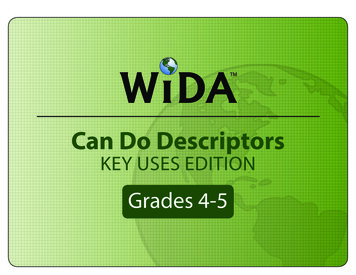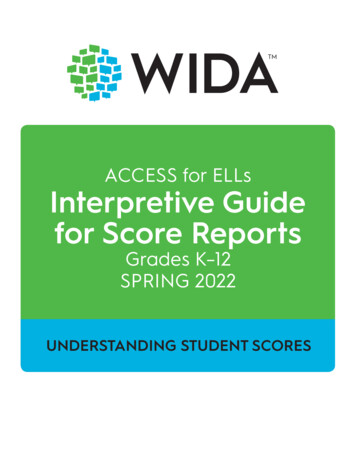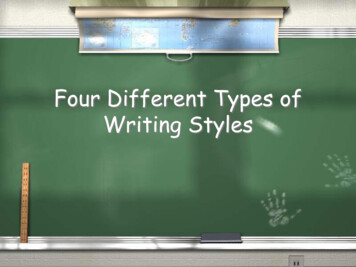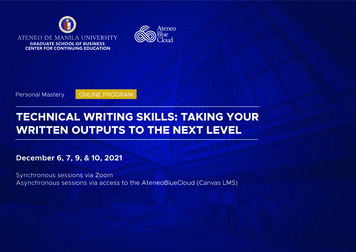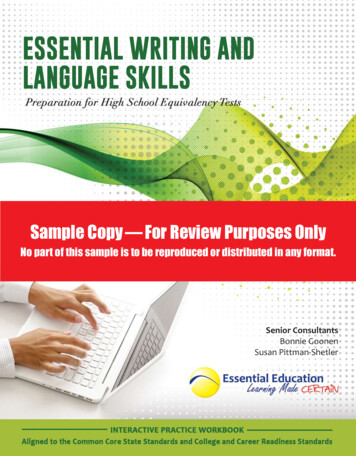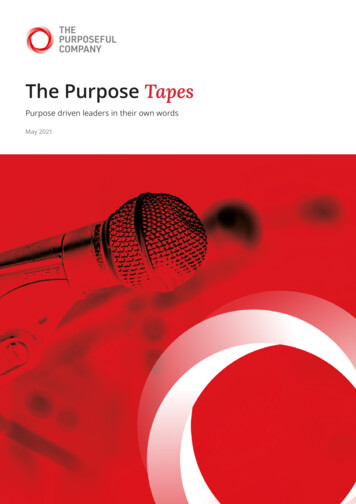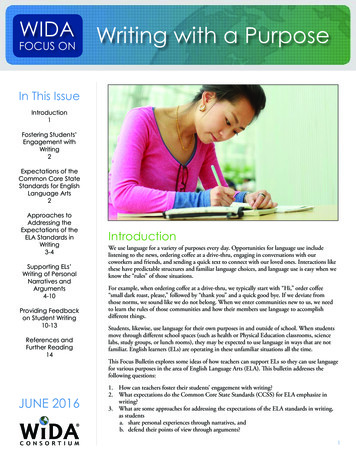
Transcription
WIDAFOCUS ONWriting with a PurposeIn This IssueIntroduction1Fostering Students’Engagement withWriting2Expectations of theCommon Core StateStandards for EnglishLanguage Arts2Approaches toAddressing theExpectations of theELA Standards inWriting3-4Supporting ELs’Writing of PersonalNarratives andArguments4-10Providing Feedbackon Student Writing10-13References andFurther Reading14JUNE 2016IntroductionWe use language for a variety of purposes every day. Opportunities for language use includelistening to the news, ordering coffee at a drive-thru, engaging in conversations with ourcoworkers and friends, and sending a quick text to connect with our loved ones. Interactions likethese have predictable structures and familiar language choices, and language use is easy when weknow the “rules” of those situations.For example, when ordering coffee at a drive-thru, we typically start with “Hi,” order coffee“small dark roast, please,” followed by “thank you” and a quick good bye. If we deviate fromthose norms, we sound like we do not belong. When we enter communities new to us, we needto learn the rules of those communities and how their members use language to accomplishdifferent things.Students, likewise, use language for their own purposes in and outside of school. When studentsmove through different school spaces (such as health or Physical Education classrooms, sciencelabs, study groups, or lunch rooms), they may be expected to use language in ways that are notfamiliar. English learners (ELs) are operating in these unfamiliar situations all the time.This Focus Bulletin explores some ideas of how teachers can support ELs so they can use languagefor various purposes in the area of English Language Arts (ELA). This bulletin addresses thefollowing questions:1. How can teachers foster their students’ engagement with writing?2. What expectations do the Common Core State Standards (CCSS) for ELA emphasize inwriting?3. What are some approaches for addressing the expectations of the ELA standards in writing,as studentsa. share personal experiences through narratives, andb. defend their points of view through arguments?1
How Do Teachers Foster Their Students’ Engagement withWriting?In this bulletin, we highlight key practices for fostering engagement with writing,fully acknowledging that teachers have many approaches available to them andthat it is beyond the scope of this bulletin to address all of them. The key practiceswe highlight in this bulletin are as follows:1. Teachers create environments in which students have opportunities toconnect writing with their own lives. They draw on their students’ home,community, and school experiences to develop as writers.2. Teachers create opportunities for students to “own literacy.” To them,“keeping ownership and student agency at the top of the academic agenda isreally important” (Au, personal communication). Owning literacy means thatstudents see the power of language and literacy as tools to achieve their ownpurposes as they engage with the world.3. Teachers have a “can do” attitude toward their students’developing writing practices, even though their students’writing may contain grammatical errors.4. Teachers work on building student writing potential byexplicitly drawing student attention to language choiceshidden in “good writing.” For example, they draw attentionto how the language choices in writing a personal narrative aredifferent from language used in writing arguments as requiredby the CCSS for ELA, and they make those differences visibleto their learners.“ language is learned, not becausewe want to talk or read or writeabout language, but because wewant to talk and read and writeabout the world. especially forchildren, language is the mediumof our interpersonal relationships,the medium of our mental life, themedium of learning about the world”(Cazden, 1977, p. 42)Larger purposes of writing for the purposes of personal fulfillment, for capturing and sharing your humanexperiences with others, for participating in the public discoursearound a public issue.Kathy AuWhat Expectations Do the Common Core StateStandards for English Language Arts Emphasize in Writing?The Common Core State Standards for English Language Arts (CCSSA.ELA) hold high expectations for what students do in writing,such as:Students will1. Write arguments to support claims in an analysis of substantive topics or texts, using valid reasoning and relevant and sufficientevidence (CCSS.ELA-LITERACY.CCRA.W.1).2. Write informative/explanatory texts to examine and convey complex ideas and information clearly and accurately through theeffective selection, organization, and analysis of content (CCSS.ELA-LITERACY.CCRA.W.2).3. Write narratives to develop real or imagined experiences or events using effective technique, well-chosen details, and well-structuredevent sequences (CCSS.ELA-LITERACY.CCRA.W.3).While the CCSS for ELA are clear about which text types students are expected to write (e.g., arguments, informative/explanatory,narratives), what is not clear is what language choices are needed to write good arguments, informative/explanatory texts, and narratives.We will explore some possible approaches to address the language expectations implicit in various text types required by CCSS in ELA.We will also connect these approaches with two of the WIDA Key Uses of academic language, Recount and Argue, which are described inthe next section.2WIDA Focus On Writing with a Purpose WCER University of Wisconsin–Madison www.wida.us
Keeping this theory in mind, WIDA has identified four ways of usinglanguage (known as Key Uses of academic language). Figure 1 showsthese Key Uses. The WIDA Key Uses correspond to the AnchorStandards in CCSS for ELA; this is shown in Table 1.aching andor TeLeaftrnextnDISCUSSingTeachers use many different approaches when they teach EnglishLanguage Arts to English Learners. Some approaches focus on accuracyof grammar and teach writing through discrete grammar skills,emphasizing correct tense usage or punctuation. In the CCSS for ELA,the focus is not only on correct grammar usage, but also on effectivecommunication for different purposes. This focus on sophisticated andstrategic language choices calls for an approach to teaching language thatemphasizes language use. One such approach is grounded in SystemicFunctional Linguistics Theory, developed by Halliday and others (e.g.,Christie & Martin, 1997; Halliday, 1978, 1994; Martin, 1993). Thistheory describes typical ways in which students are expected to uselanguage in and across academic contexts and for various purposes.CoWhat are Some Approaches to Addressing theExpectations of the English Language Arts Standards inWriting?Figure 1. Key Uses of Academic LanguageInteract with othersor with text to build andshare knowledgeRECOUNTEXPLAINRetell to displayknowledge ornarrateexperiencesor eventsClarify the why orthe how of ideas,actions, orphenomenaKey Usesof AcademicLanguagePersuade by makingclaims supported by evidenceARGUETable 1. WIDA Key Uses of Academic Language with Corresponding ELA Anchor StandardsKey UseELA Anchor StandardsRecount—To displayknowledge or narrateexperiences or events.Anchor Standard for WritingCCSS.ELA-LITERACY.CCRA.W.3Write narratives to develop real or imagined experiences or events usingeffective technique, well-chosen details and well-structured event sequences.Explain—To clarify the“why” or the “how”of ideas, actions, orphenomena.Anchor Standard for WritingCCSS.ELA-LITERACY.CCRA.W.2Write informative/explanatory texts to examine and convey complex ideasand information clearly and accurately through the effective selection,organization, and analysis of content.Argue—To persuade bymaking claims supportedby evidence.Anchor Standard for WritingCCSS.ELA-LITERACY.CCRA.W.1Write arguments to support claims in an analysis of substantive topics or textsusing valid reasoning and relevant and sufficient evidence.Discuss—To interact withothers to build meaning,contribute ideas, andshare knowledge.Anchor Standard for Speaking and ListeningCCSS.ELA-LITERACY.CCRA.SL.1Prepare for and participate effectively in a range of conversations andcollaborations with diverse partners, building on others’ ideas and expressingtheir own clearly and persuasively.WIDA Focus On Writing with a Purpose WCER University of Wisconsin–Madison www.wida.us3
In the next section, we highlight the use of two of the Key Uses,Recount and Argue. In this section, we walk into two classroomsto examine how to teach language in ways that foster students’agency and engagement with writing.Both classroom teachers use various levels of scaffoldingthroughout the year to support students to be successful writers,including macro- and micro-scaffolding (Schleppegrell &O’Hallaron, 2011). Macro-scaffolding involves planning aseries of units or lessons throughout the year that build on eachother incrementally in such a way that students need less andless support as they move toward the writing of more complextasks. Micro-scaffolding occurs at the lesson level, by structuringactivities to move students toward more independence within alesson. For students to become successful writers, they need todevelop and solidify their ideas, analyze how authors use languagein mentor texts and co-construct an approach together beforethey engage in independent writing. Following this scaffoldingprocess gives students a chance to take ownership of their learningas the scaffolds are gradually dismantled when students no longerneed them (Byrnes, 1998). We see examples of those two levels ofscaffolding in these two example classrooms: A 4th grade EL teacher, Ms. Sorensen, whose students aresharing personal experiences through narratives A middle school EL teacher, Mr. Creapo, whose eighth gradersare defending their position on racism in the past and present.Macro- and Micro-Scaffolding TowardsWriting of Personal Narratives1.Develop ideas around a topic of choice(e.g., by using student first language,viewing, talking, and reading, going onfieldtrips).2.Model how authors use language byanalyzing mentor texts (which match thedesired genre of the final product).3.Develop working templates to support thereading and writing of the genre.4.Co-construct texts together as a wholeclass and in small groups.5.Allow students to write collaboratively on atopic.6.Engage students in independent writingusing various supports, if needed (e.g.,class-created graphic organizers, workingtemplates, or other supports from previouslessons).How do Teachers Support ELs’ Writing as They SharePersonal Experiences Through Narratives?Ms. Sorenson’s students have been working on writing for a varietyof purposes and across various disciplines. They wrote informationreports on how Minnesota got its name and drew textual evidencefrom texts written by people indigenous to Minnesota. Thenext step is to write personal narratives as part of a larger transdisciplinary unit. They start by reflecting on personal experiencesand making a class gallery illustrating these experiences. Studentsshare different experiences they have had, such as making a friendon the playground, going to an older brother’s basketball game,helping Grandma make supper, going to a cousin’s wedding, orbeing bored and going over to a friend’s house. During this process,students learn that even seemingly insignificant experiences canbe worth capturing and sharing with others. They realize thatthe reason for writing personal narratives is bigger than just goodsentences, punctuation, and spelling: It is to capture and share theirpersonal experiences using language strategically.After students establish a purpose for writing and develop ideasaround which experiences they want to write about, Ms. Sorensonshares a variety of texts that model personal narratives. She readsa couple of texts and draws students’ attention to how personalnarratives are organized and how authors use language to capture4and share personal experiences. They develop a working templateto capture the organization of personal narratives with languagechoices. Their template reflects that most personal narratives startwith an orientation telling the reader what the story will be about,followed by a series of events leading to a conclusion. Studentsnotice that some narratives include dialogue, and open up with acatchy hook or a line of a dialogue or a question. The purpose ofreading these mentor texts is to learn the structures of narrativesand to identify how authors share their own experiences and whatlanguage authors use to achieve that purpose. During this time,students use graphic organizers to keep track of their learning ofhow narratives are structured as well as how authors use variouslanguage choices to create an orientation, to sequence events, andto draw a conclusion.After students become familiar with organizational structures ofnarratives, Ms. Sorenson and the students co-construct a classnarrative. Figure 2 shows common characteristics of narrative texts.During this phase, students choose a common experience they allparticipated in, and Ms. Sorenson writes down what the studentsare saying, guiding them to make effective language choices andpointing out the organizational structures such as orientation,WIDA Focus On Writing with a Purpose WCER University of Wisconsin–Madison www.wida.us
Figure 2. Narratives: Key Uses—RecountNarratives: Key Use—RecountPurposes and Types of NarrativesThere are different types of narratives. Some are fictional, such as fairy tales, mysteries, science fiction stories,adventure stories, myths and fables, legends, and the like (Derewianka, 1999). Others are nonfiction, suchas autobiographies, and biographies in which someone’s life is recounted. Other types of narratives arepersonal narratives, which allow the writer to capture and share one’s human experiences with others,providing a tool to create community (Au, personal communication; Brisk, 2015).Instructional implications: How can I broaden the repertoire of different types of narratives? (e.g., do we tendto write more fictional narratives, such as fairy tales, and not as many biographies?) How can I help studentsconnect writing of personal narratives to larger purposes? How can I validate students’ personal experiencesso that they can get excited about capturing and sharing them with others?Organizational Structures of NarrativesNarratives may begin with an orientation that provides the reader/listener with the background necessaryto understand the topic. The orientation presents information about who was involved, where it happened,when it happened and continues with a series of events ordered in chronological sequences. If the recountis more story based, the organizational structure is commonly called a story map (orientation, complication,resolution). Narrative structures differ among cultures, and students from other cultures will likely follow thenorms of their cultures when writing personal narratives (Brisk, 2015).Instructional implications: How can I expose my students to a full range of narrative types? How can I providestudents with knowledge of structures of different types of narratives as scaffolds for writing?Typical Language Features Narratives May IncludeDiscourse Dimension Ideas that follow a timeline (although events may not always occur in strict chronological sequence) Time connectives (later in the afternoon, the day before), although sometimes these may remain implicitSentence Dimension Past tenses to refer to past time Short punchy sentences or fragments to create special effects (e.g., It hurts. A lot! And then Bump.Bump. Bump! Ouch! Yikes!)Word/Phrase Dimension Adjectives (e.g., long and boring night), metaphors and similes (e.g., as slow as a turtle), prepositionalphrases (e.g., in the middle of the night) to create detailed descriptions to help readers visualize the story A variety of saying verbs (e.g., grumbled, whispered, shouted), thinking verbs (e.g., considered,pondered, understood), doing verbs (e.g., bumped into, played) Personal pronouns to refer to people in the storyInstructional implications: How can I provide students with knowledge of structures of different types ofnarratives as scaffolds for writing?WIDA Focus On Writing with a Purpose WCER University of Wisconsin–Madison www.wida.us5
Figure 3. Sample WritingThe PartyNotice how thestudent“Wake up sleepy head,” my mom whispered.“Huh?” I mumbledCreated an effective hookwith a quote.“We’re going to a party!” my mom told me.Used effective techniquessuch as metaphors andsimiles.“But I don’t want to.” I grumbled.My mom made a sad dog face.“Fine,” I told her.My sisters, Mom and Dad, I went in the car. It was boring as a watchinga turtle walking across a field. Bump, Bump, Bump. The car was goingup and down. The curvy road was bumpy.Then, I realized “It’s a wedding!” I shouted.“Why do we need to come here?” I asked myself.Everybody had fun except me. I was feeling sad and lonely as a squirrelon its own. Then, I saw my best friends and cousins.I asked them, “Do you guys want to play?”“Sure,” they responded.Created a clear eventsequence withoutoverusing sequence words.Used a variety of sayingverbs throughout(whispered, mumbled,grumbled, shouted, asked,responded, told).Provided a resolution anda concluding statement.We played tag, Hide-N-Seek, and Freeze Tag. In the end, I learned tohave fun at other places and to try new things.sequence of events, a conclusion, and the language features. Duringthis phase, the teacher provides more scaffolding by pointingout a variety of temporal connectives (e.g., soon after, later thatday, in the afternoon, at the end of the trip), use of past tenses torecount past experiences (e.g., were looking for, had found, waited)as well as a variety of cohesive devices, such as synonyms to referto the students (e.g., students, children, fourth graders, kids). Othersupports include an outline to follow the organizational pattern ofpersonal narratives, word banks with transition words, and wordwalls with saying, thinking, and feeling verbs.The final step is independent writing. The goal of the independentwriting is not to recreate existing texts and follow templates, butto create original texts. Some students choose a partner to writewith and others are ready to write alone. During the independentwriting, students are able to use their graphic organizers, mentortexts, word banks, and organizational frames as supports. Somestudents might rely heavily on the templates and word banksduring the independent writing, while others will not need them,depending on their levels of English language development. Withappropriate supports and fully developed ideas, students should beable to produce their own texts.Figure 3 shows a sample of a student writing analyzed through thelanguage choices this student made when describing his personalexperiences.How Key Uses Are Impacting My Practice“By focusing on the Key Uses, I am becoming a more effective language teacher. I can teach language forlarger purposes – which is my responsibility as an ELD teacher.”“The mindshift is happening for me, as an ELD teacher. If my students are going to communicate morepowerfully, they need to know what a good argument looks like. I am fine-tuning my instruction to support myELs better.”“My students are learning that different language choices belong in different pieces of writing. Emotivelanguage does not belong in the language of science, but it’s important for arguments.”Mr. Creapo, Denver Public Schools6WIDA Focus On Writing with a Purpose WCER University of Wisconsin–Madison www.wida.us
How Can Teachers Support ELs’ Writing as They DefendTheir Points of View Through Arguments?Mr. Creapo is a middle school ELD teacher in Hill Campus ofArts and Sciences in Denver Public Schools. His students aremainly Latino from Mexico, El Salvador, Colombia, Ecuadorand other countries. They are all English learners. For thepast several weeks, they have been researching the state ofrace relations in the United States. This issue is very near totheir hearts for many reasons, one of them having to do withthe current election season. Students bring issues they hearon the news into their classroom to discuss, and Mr. Creapotaps into his adolescents’ inner sense of social justice to useas the foundation for meaningful writing of arguments. Thisprocess situates writing within the larger purpose of literacy forcitizenship, a tool for participation in the public discourse onthe issue of race relations in the United States. Mr. Creapo andhis students have been working toward these ELA standards:Write arguments to support claims with clear reasons andrelevant evidence C) Use words, phrases, and clauses tocreate cohesion and clarify the relationships among claim(s),counterclaims, reasons, and evidence. D) Provide a concludingstatement or section that follows from and supports theargument presented. (CCSS.ELA-Literacy. W. 8.1)The learning target for this unit is the following:I can write arguments with clear reasons and relevantevidence. I can argue for my opinion in writing using emotive,objective, and evaluative language.The final assignment is an editorial written to convincestudents to take action to expose racism in the past and present,starting within the school. The students use a specific processfor developing an argument. They start by sharing personalexperiences they have had with being discriminated against fortheir skin color and language. Then they watch a documentaryabout racism and segregation in Denver Public Schools andengage in oral discussions. Next, students become familiarwith the genre of editorials by reading a range of editorials andidentifying some structures of editorials and language features.Figure 4 shows common characteristics of arguments withstructural components and language features organized bydiscourse, sentence, and word dimensions.Here’s what they find: Editorials include personal experiencesusing evaluative language leading to claims supported byreferences to statistics and research using objective language;experiences of other people using emotive language; and,conclusions, sometimes calling for action.Notice how the teacher scaffoldsthe writing process of arguments atunit and lesson levels:1.Develop ideas around a topic of significanceto students (e.g., by viewing, talking, andreading, sharing personal experiences,interviewing other students)2.Model how authors use language byanalyzing mentor texts (which match thedesired genre of the final product)3.Co-construct texts together as a whole classand in small groups before asking students toproduce independent writingEvaluative, Emotive, and ObjectiveLanguage in ArgumentsRecognizing how authors use evaluative, emotive,and objective language in arguments can be a toolto uncover how authors advance their perspective.This awareness is necessary to engage students ina critical analysis of what they hear and read. It willempower them to take a critical stance towardknowledge and information by recognizing author’sbias, problematizing mainstream knowledge, andcritiquing different views (Gibbons, 2009).Evaluative language: important, significant,necessary, impressive.Purpose: to persuade the reader to see things in thesame way as the authorEmotive language: catastrophic, magnitude, heartwrenchingPurpose: to get hold of the readers’ emotionsObjective language: research states , studiesconfirm instead of I think Purpose: to create a logical appeal by presentingfacts using research or statisticsThen they co-construct an argument together as a class, withstudents providing the language, and the teacher guidingWIDA Focus On Writing with a Purpose WCER University of Wisconsin–Madison www.wida.us7
Figure 4. Arguments: Key Uses—ArgueArguments: Key Use—ArguePurposes and Types of ArgumentsThe purpose of arguments in English Language Arts is to persuade the audience to a position, point of view orinterpretation, via letters to the editor, or in political speeches, for example (Butt et al., 2000, Derewianka, 1990).Arguments include a process of making a claim and using evidence to support or refute that claim. One of the largerpurposes for writing arguments for students is for citizenship: to participate in the public discourse on a larger issue.Instructional implications: How can I provide students with opportunities to examine arguments in media? How canI help students connect writing of arguments to larger purposes? How can I tap into students’ inner sense of justiceas fuel for defending points of view they are passionate about?Organizational structures of argumentsGenerally, arguments begin with a statement of position that provides some background information about theissue in question. The remainder of the text provides the argument (point of view), evidence, and examples tostrengthen the claim. An argument ends by summing up the position and/or calling to action. Sometimes a writerincludes both sides of the argument. In that case, the conclusion includes recommendations favoring one side.Instructional implications: How can I provide students with knowledge of structures of different types of argumentsas scaffolds for writing?Typical Language Features Arguments May IncludeDiscourse Dimension Connectives to sequence claims (e.g., first, second, third, finally, in conclusion, to summarize, therefore) topresent counter-claims (e.g., however, nevertheless, on the other hand) to show relationships of similarity ordifference (similarly, moreover, nevertheless, despite this, on the other hand) Summary statements used to pull ideas togetherSentence Dimension A variety of tenses may be used depending on the purpose (past tense to summarize past, present tenses tostate the present, if-then clauses to state real or imagined effects) Modality to present arguments or claims as possibilities rather than facts (it is likely that, it may be that)Word/Phrase Level Dimension Topic-specific vocabulary (racism, segregation, racial divide, hatred) to speak with authority Evaluative language indicating writer’s personal belief or stance (e.g., it is extremely unlikely) Emotive language to create emotional appeal (e.g., devastating, heart-wrenching) Language referring to research or statistics to create logical appeal (e.g., research studies have found that Twenty percent of students reported that ) Language to create moral appeal (e.g., it is our duty to ) Language choices to connect with the audience (e.g., peers vs. adolescents) Modal verbs to call to action (we must act now, we should not stop )Instructional implications: How can I make these language features more explicit to my ELs? What activities shouldI consider to help my ELs choose language specific to audience?8WIDA Focus On Writing with a Purpose WCER University of Wisconsin–Madison www.wida.us
the language choices to create a strong claim, and provide evidence and reasoning. Students edit and rewrite together to scaffold thewriting process through a think-aloud and modeling. Following the co-construction phase, the students write their pieces independently.Students are given a choice to use the templates and other supports they developed earlier as supports during writing, including the piecethey co-constructed together. Some students choose to use a scaffolding framework for argument, like the example shown in Figure 5,which is adapted from Gibbons, 2009.Figure 5. Scaffolding Framework for Argument with CounterargumentsTitle:Say what this argument is about, and give your opinion.Claim: Racism is the issue that causes many problems.Many people argue that However, in my opinion Give your reasons for your opinion (your arguments).There are a number of reasons why this is the case (why you believe that).First In addition Moreover Finally (optional, if counterarguments are provided) Now give other people’s reasons for disagreeing with your opinion(counterarguments).On the other hand In addition It has also been suggested that Give your conclusion. Remind the reader of your view and summarize your reasons.However, overall it can be argued that because While students had been accustomed to using a five-paragraph format for other essays, they were faced with the question: Is that formatthe most appropriate? By reviewing a range of different editorials, they learn that journalists make choices about format based on theaudience, the genre, and the purpose.Figure 6 shows an editorial from one student from Mr. Creapo’s class. The student writing was shortened for the purposes of thispublication. A brief analysis is provided as a starting point to analyze student writing of an editorial. The structure of writing follows thescaffolding framework students used in writing an argument.WIDA Focus On Writing with a Purpose WCER University of Wisconsin–Madison www.wida.us9
Figure 6. Racism and StereotypesStudent Writing SampleTeacher AnalysisThere has been racism going on back in the days in U.S and still goes ontoday. For example, slavery, segregation, and KKK. All of these things arethe main ones of segregation and racism. Many people argue that racismcaused was the thing of the past. However, in my opinion, racism stillcontinues today.Statement of position or claim. Apreview of examples is provided.There are a number of reasons why racism still happens today.Introductory statement isprovided to state what’s coming.First, Donald Trump says he is not racist but then he says things like “When I’mpresident I am building a wall so no more Mexican immigrants don’t cometo the U.S because they bring guns drugs and other things.” That quotewas very racist and that can cause lots of problems when he becomespresident.In addition, there are still a lot of stereotypes. For example, they say all blackpeople like chicken and watermelon, or all white people like Starbucks, allAsia
Language Arts 2 Approaches to Addressing the Expectations of the ELA Standards in Writing 3-4 Supporting ELs’ Writing of Personal Narratives and Arguments 4-10 Providing Feedback on Student Writing 10-13 References and Further Reading 14 Introduction We use language for a variety of purposes every day
